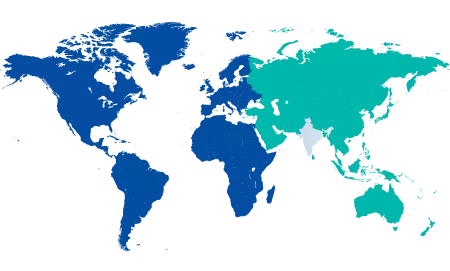-
Centre of
Excellence
Centre of Excellence
- Cancer Care/Oncology
- Cardiology
- Cardiothoracic Vascular Surgery
- Gastrointestinal Science
- GI Surgery
- Gynaec Oncology
- ICU and Critical Care
- Kidney Transplant
- Medical Gastro
- Medical Oncology
- Nephrology
- Neurology
- Neurosurgery
- Organ Transplant
- Orthopaedics
- Paediatric Cancer Care
- Paediatric Cardiology
- Paediatric Neurology
- Pulmonology (Respiratory and Sleep Medicine)
- Renal Sciences
- Robotic Assisted Surgery
- Spine Care
- Surgical Gastro
- Surgical Oncology
- Urology
- Woman and Child Care Centre
Other Specialities
- Accident and Emergency Care
- Anesthesiology
- Clinical Haematology
- Clinical Psychology
- Dental Medicine
- Dermatology
- Diabetes and Endocrinology
- Ear Nose Throat
- Electrophysiology
- Fetal Medicine
- General Medicine
- General Surgery
- Growth and Hormone
- Internal Medicine
- Interventional Radiology
- Laboratory Medicine
- Laparoscopic Surgery
- Microbiology
- Minimal Access Surgery
- Neonatology & NICU
- Neuro otology
- Nuclear Medicine
- Nutrition And Dietetics
- Obstetrics and Gynaecology
- Ophthalmology
- Oral Maxillo Facial Surgery
- Paediatric And Child Care
- Paediatric General Surgery
- Paediatric Intensive Care Unit
- Paediatric Surgery
- Paediatric Urology
- Pain Medicine
- Pathology
- Physiotherapy
- Plastic And Cosmetic Surgery
- Psychiatry
- Psychology
- Radiology
- Radiotherapy (Oncology Radiation)
- Rheumatology
- Transfusion Medicine
- Vascular and Endovascular Surgery
- Doctors
- EM Bypass
- International Patients



Clinics








- Self Registration
- In-Patient Deposit
- Mars - Ambulance
- Corporate & PSU
- Insurance Helpdesk
- Awards And Achievements
- Careers
- Contact Us

Central line and chemo port use
Central Line and Chemo Port Use Treatment in EM Bypass, Kolkata
Central Lines and Chemo Ports are useful in cancer treatment. They provide a reliable way to administer chemotherapy, blood products, and other drugs directly into veins. Central Lines and Chemo Ports are beneficial for patients requiring long hours of intravenous (IV) therapy or those whose veins are not easily accessed.
At Manipal Hospitals, our oncologists have expertise in performing Central Line and Chemo Port Use treatments in EM Bypass, Kolkata.
Types of Central Line and Chemo Ports Used in Cancer Treatments
-
Peripheral IV Lines: Short catheters are placed on the forearm for short-duration treatments.
-
Peripherally Inserted Central Catheter (PICC): Catheters are inserted into a vein of the upper arm and go down to a large vein near the heart.
-
Central Venous Catheter (CVCs): Catheters are introduced in the veins of the chest, neck, or groin and are passed to the central vein near the heart.
-
Chest Ports: Implanted under the skin in the surgical site. These devices, also called Mediports or Port-a-Caths, are located in the upper chest area. Chemo Ports allow repeated access without multiple needle sticks.
What Happens Before the Procedure?
Before Central Line or Chemo Port placement, the patients are evaluated thoroughly with blood tests and imaging studies to ensure eligibility and see where to place the catheter or port. Patients will also be informed regarding the risks, complications, and benefits associated with the procedure.
How is the Procedure Performed?
Insertion depends on the device being inserted:
-
PICC Lines: It is placed under local anaesthesia with the assistance of ultrasound. A nurse places the catheter through a vein in the arm. The catheter is advanced until it reaches the large vein near the heart. PICC line insertions may take 30 to 60 minutes to complete.
-
CVCs and Ports: The devices are implanted under the skin via local or general anaesthesia. When placing a port under the skin, a little incision is made on the chest. A catheter is then inserted from the port to a large vein, giving direct access to the bloodstream. These procedures usually take 30 minutes to an hour.
What to Expect After the Procedure?
After insertion, the Central Line or Port is secured and dressed with a sterile dressing. You will be monitored for any immediate complications. If nothing arises, doctors will give post-recovery instructions and discharge you. It is necessary to attend follow-ups scheduled by our doctor.
Central Line and Chemo Port Use—Possible Risks
Just like any procedure, insertion of Central Lines and Chemo Ports can lead to some complications. These include
-
Infection
-
Blood Clots
-
Mechanical issues like displacement or blockage
-
Bloodstream infections
-
Air embolism
-
Collapsed lung
-
Scarring
-
Nerve damage
It is important to note that these risks occur rarely and only in select cases. Manipal’s oncology team in EM Bypass, Kolkata, takes every precaution to ensure the procedure is done safely with minimal complications.
FAQ's
A Central Line has various advantages since it provides long-term intravenous access for the infusion of drugs, fluids, blood products, and Chemotherapy. The frequency of several needle punctures is reduced, and it can be left in place for weeks or months.
Not really; anaesthesia will be administered during the procedure to numb your pain. However, you can feel a mild, temporary discomfort when the catheter is passed through the vein.
The area around the catheter is cleaned, and local anaesthesia is applied to numb the site. The catheter is then cautiously withdrawn, ensuring there is no bleeding. It is then covered using a sterile dressing. Patients are kept under surveillance for a short time before being sent home.
Of course. Children can have a Chemo Port placement procedure. This is often performed in Paediatric Oncology cases when children require long-term intravenous chemotherapy. Placement of a Chemo Port, however, can be a risky procedure. Our oncologists at Manipal Hospitals are well-versed to conduct the Chemo Port Insertion procedure in EM Bypass, Kolkata, especially for children.
Activities that you should avoid if you have undergone a Chemo Port Insertion include:
-
Heavy lifting and engaging in contact sports
-
Swimming or bathing in hot tubs
-
Clothing that puts pressure on the Chemo Port
Our doctors at Manipal Hospitals will let you know about activity restrictions if you have undergone a Chemo Port Insertion procedure in EM Bypass, Kolkata.
Home Em-bypass Specialities Cancer-care Central-line-and-chemo-port-use



You’re on Our Indian Website
Visit the Global site for International patient services











